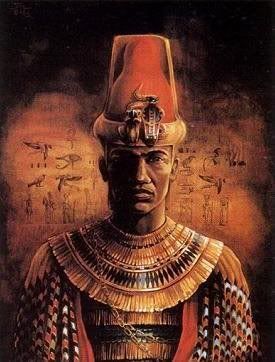


Shem Hotep ("I go in peace").
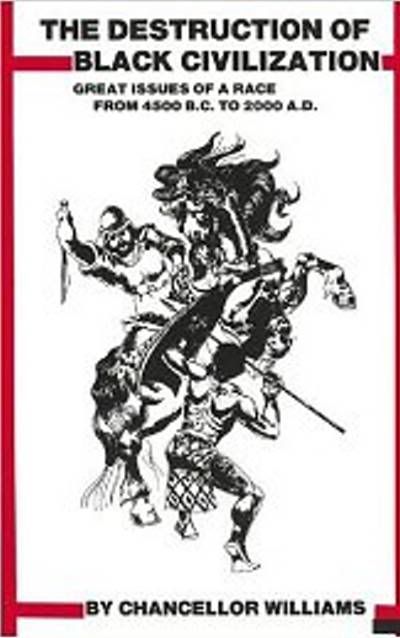
The Destruction of African Civilization
A great deal of information about the culture of Africa has been lost because of the destruction of ancient records. Great libraries in several African cities were burned, looted, and their treasures stolen. The library in Thebes was destroyed by an invading Assyrian army in 661 B.C. [John G. Jackson]
The Land of the Blacks, as it was referred to, was a vast and big world, two million square miles, not limited to the southern region. The Ethiopian Empire once extended from the Mediterranean at the north and southward, to the source of the Nile. Egypt, it should be pointed out, was the northeastern region of ancient Ethiopia.
The six cataracts of the Nile were the great watermarks in the heartland of the Blacks from whence African culture spread over the continent. This northern sector had been the object of world attention from the earliest times. Interestingly, the ancients referred to Egyptians and Nubians as Ethiopians. Nubians were later called 'negroes" by Westerners.

Rameses II
It was during the period of Rameses II's reign, about 1400 B.C.E., that the racial composition of the Egyptian Dynasties began to change. Rameses II, moved his capital city from Luxor to Memphis, then finally to the Delta region, in order to keep a constant vigilance over the Assyrian and Palestinian wars that he had involvement in.
The African domination of Egypt began to diminish. The infiltration of Asian, Libyan, and other non-Black races in Egypt caused an insurrection that led to the outbreak of a civil war that lasted for 25 years. The war had turned and the non-Africans became empowered, with the Hyksos becoming the Pharaohs of Egypt.
During this same period of time, a number of other major events were transpiring around the world, many of which included Africans: Egypt was in a state of total decline; a Libyan by the name of Osorkon I ruled the throne; the "Third Golden Age" of Egypt had come to an end; large groups of people fled Egypt; Nubians retreated back southward; and many of the Africans took to the seas.
There is a natural ocean current that flows from the West Coast of Africa to the Americas (the Caribbean, South America, Mexico, etc.). It has been recorded that Africans were the first known "gods of the Olmecs" in Mexico (1400–1300 B.C.). African sculptures, pyramids, and large colossal heads still exist in Mexico that support reports of Mexican and African relationships in the early Americas.
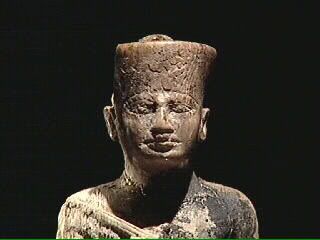
Egyptian Philosophy
From the time of Pharaoh of the Third Dynasty to Pharaoh Khufu of Cheops of the Fourth Dynasty (builder of the great pyramids of Giza), we can see the superior intellect of these ancient African people. Their understanding of mathematics and knowledge of the heavens and the sun with relationship to the stars is astonishing. These people had studied astronomy in Egypt and the lands south of Punt for thousands of years. This is evidenced by the monuments that remain such as the Great Sphinx of Giza, the half human animal figure that dates back to the ancients of the ancients.
Kemet or Ta-merry was the center of learning. People from all over the Mediterranean came to study in their Mystery Schools. The Greek philosophers were students or had some contact with the students of the Egyptian institutions of learning. The Greeks who learned the ancient teachings of science, mathematics, astronomy, medicine, masonry, etc. were considered enemies of the state of Athens and were imprisoned exiled, or put to death.
There is in existence, a list of alleged Greek philosophers, who were regarded as undesirables in the Greek State in which they were citizens. These philosophers continued accepting their source of wisdom and knowledge from Egypt (Kemet), at the risk of physical injury to themselves. They were men who kept the records in their heads, and operated in deep secrecy in fear of the state (Greece).
Any Greek citizen that embraced foreign ideology was considered a criminal and a "teacher of an alien philosophy." This charge was lodged against Socrates, Aristotle, and others in the Greek government. It was Socrates who was put into prison and later sentenced to death by the same people who now claim his teachings as their own. All Egyptian temples carried inscriptions on the outside addressed to the Neophytes (initiates). And among them was the injunction "Know Thyself." Socrates copied these words from the Egyptian temples, but was not the author.
The Egyptian Mystery system was also a secret order. Membership was gained by initiation and a pledge of secrecy. The teachings were graded and delivered orally by the Neophyte; and under these circumstances of secrecy, the Egyptians developed secret systems of writing and teachings, and forbade their initiates from writing what they had learned. After nearly five thousand years of prohibition against the Greeks, they were permitted to enter Egypt for the purpose of their education. First through the Persian invasion and secondly through the invasion of Alexander the Great. The Greeks made the best of their chance to learn all they could about Egyptian culture. After the invasion of Alexander, the royal temples and libraries were plundered and pillaged, and Aristotle's school converted the library of Alexandria into a research center.
"It is Imhotep," said Sir William Osler of John Hopkins University, "who was the real father of medicine. The first figure of a physician to stand out clearly from the mists of antiquity." Imhotep, a multi-level genius, called "God of Medicine, Prince of Peace, and a type of Christ." If Imhotep designed the first "step pyramid" in approximately 2680 B.C. (and he did), how did Pythagoras develop the so-called "Pythagorean Theorem," the formula for the triangle, when he lived 540 B.C., 2100 years after the pyramid was built?
The teachings were solely of the indigenous Africans of the Mystery System commonly in use along the Nile Valley and Great Lakes regions of Northern, Eastern, and Central Africa.
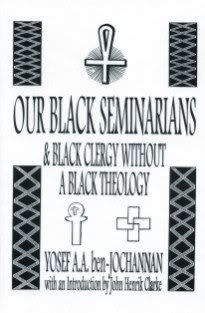
Religion and Science of the Africans
Religion has been defined as a "propitiation or conciliation of powers superior to man," which are believed to direct and control the course of nature and human life. Humans are believed to have evolved through three states of beliefs.
The Age of Magic
The Age of Religion
The Age of Science
For thousands of years before religion was known, man believed in the principles of magic, and strove to put them into practice in his daily life.
In the book Africa Origins of the Major Western Religions, Dr. Yosef ben-Jochannan writes:
Paganism, Voodooism, Witchcraft, Fetishism, Black Magic, Obyah, and Oledamare are just a mere sampling of the many names relegated to a few of the righteously sacred religions of solely traditional indigenous African origin. Approximately 750,000 B.C.E., and possibly before this date, the indigenous African people, the so-called Bantus, Bushmen, Pygmies, Hottentots, Negroes, and others bearing such labels of inferiority, have been honoring a 'superior force' or being prior to the recording of history.
The "Twa" (referred to as pygmies), recorded as being the first inhabitants of the world, had the earliest mode of worship recognizable in propitiation of the superhuman power.
What then is the foundation of African Spirituality? Our ancestors believed that man must place the utmost importance in the quest to "know thyself," as the deification of man was highly regarded. The Egyptians (Africans) taught that the soul of man, if liberated from the body, could become God-like. According to this concept, they also held that man would be among the Gods in his lifetime on earth and attain what was called the "Beautific Vision," (changed to "saints" in Christendom).
In Africa spirituality, the name ascribed to God, depended mainly on where in Egypt (Africa) a person lived. Those living in Thebes referred to God as "Ra," in Memphis as "Amon or Amen," and in Nubia as "Ptah." African spirituality was simply a holistic approach to life, possessing no one train of thought to dominate the mind. African spirituality was based on the Osirian doctrine and the principles of Maat. In brief, the central principle of Maat is that the Gods serve humanity as humanity serves the Gods. Maat is divine harmony. It is built upon, and reflection of understanding the celestial realm.





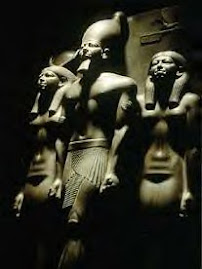









No comments:
Post a Comment